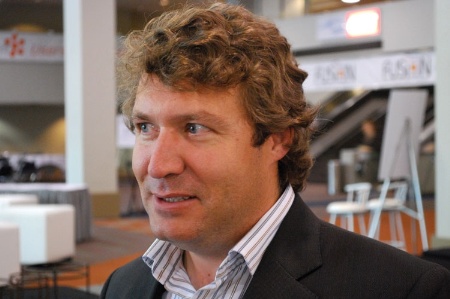Source: Stephen Downes
Look what they’ve done to my Mooc: ‘as deployed by commercial providers they resemble television shows or digital textbooks with – at best – an online quiz component,’ argues Stephen Downes
When The New York Times declared 2012 the “Year of the Mooc”, you would have been forgiven for thinking that the term – which stands for “massive open online course” – had been coined some time that year.
Not so. “Mooc” was first used five years ago in Canada by a group of academics who can claim to be the true originators of what has become the academic buzzword du jour: a type of online learning that, although not without its critics, has taken the global academy by storm.
It was Stephen Downes, senior research officer at Canada’s National Research Council, and George Siemens, then working at the University of Manitoba and now a professor in the School of Computing and Information Systems at Athabasca University, who created the online course Connectivism and Connective Knowledge in 2008: it is widely regarded as the first true Mooc.
“I approached Stephen to ask if he wanted to co-teach a course,” says Siemens. “Since this time, we have taught more than a dozen courses using a similar format and the technology that Stephen developed.”
For Downes, it was clear, even at an early stage, that there was a big future for open online learning.
“I don’t think anyone can ever expect their concept to be called the ‘concept of the year’ – it would take quite an ego to assume that. But it was evident early on that we had latched on to something when we got 100 times more participants in our course than we expected.”
The “Mooc” acronym itself emerged from conversations between two colleagues: Dave Cormier and Bryan Alexander.
At the time, Cormier was web projects lead at the University of Prince Edward Island and had been helping out with the Connectivism course (he is now project lead for student relations at the institution). For him, the newly christened Mooc was interesting but not exceptional.
“I didn’t really feel like it was much different from the other things we had experimented with,” he says. “I’ve been part of numerous groups of folks experimenting with what you can do with the internet and education for the past 10 years or so.”
It was the same for Alexander, at that time director of research and now senior fellow at the National Institute for Technology in Liberal Education. He says that it was only when Stanford University’s artificial intelligence Mooc, announced in July 2011, attracted 160,000 enrolments that he thought the medium could “get very big”.
Growing backlash
Five years down the line, the term has become commonplace. Hundreds of universities have developed Moocs, and the organisations that have established platforms to host them – such as Coursera, edX and Udacity in the US and FutureLearn in the UK – have become increasingly well known.
However, Downes fears that modern Moocs are placing less emphasis on providing an “interactive and dynamic” approach to learning (such as he championed with his 2008 course) and more on “static and passive” education.
“Moocs as they were originally conceived…were the locus of learning activities and interaction, but as deployed by commercial providers they resemble television shows or digital textbooks with – at best – an online quiz component,” he argues.
Siemens believes that attitudes towards Moocs are in a period of flux and that criticism is mounting because of what he calls the “biggest failing of the big Mooc providers”: they are simply repackaging what is already known rather than encouraging creativity and innovation.
“There has been a growing backlash against Moocs over the past year. If 2012 was the ‘Year of the Mooc’, 2013 is shaping up as the ‘Year of the anti-Mooc’,” he says.

“Moocs today…are quite different from the ones that Stephen and I developed. Our goal was to encourage the development of learners through open and transparent learning, where the process of knowledge generation was iterative – improving on the ideas of other learners and generating new knowledge through continual…improvement. Most Moocs today are more didactic.”
Siemens adds that the pedagogy employed by the major providers is “several decades behind” what is needed.
Downes is also scathing of the direction in which the three big US Mooc providers have taken his original blueprint, describing their offerings as “temporary and unimaginative, created by people who for the most part are not aware of the history of online learning”.
He adds: “I think they are marvels of marketing and of the naivety of venture capitalists. Looking at the platforms from a technological point of view, I see virtually nothing innovative. These courses [reach] 100,000 or more people, but use video lectures and old-style threaded discussion lists. The idea of Moocs as an experiment in pedagogy and educational organisation has been completely abandoned by the new platforms, to the detriment of Moocs.”
For Cormier, the evolution of Moocs since 2008 offers a microcosm of how the education macrocosm is developing.
“You can see the business influences, the division between those who believe that education is a quantifiable experience and those of us who believe it is too deeply human for measurements to guide our direction,” he says.
Business imperatives
Of the four Mooc platforms mentioned, two – Coursera, founded by Stanford professors, and Udacity, which was established after the success of the Stanford artificial intelligence Mooc – are for‑profits and funded in part by venture capitalists who expect to see financial returns.
Although he is not opposed in principle to Mooc technology being commercialised, Downes does harbour concerns about how the interests of business might affect the direction of travel for courses that purport to subscribe to the ideals of openness.
“We have already seen that in cases where education is managed by commercial corporations, the bottom line often takes precedence over student needs,” he says. “It’s a bit like a Disney movie. The purpose isn’t so much to entertain and educate the child as it is to move Disney products off the store shelves.”
He adds: “At the university level, this ultimately can be much more sophisticated, but is nonetheless a concern. So I think there is a critical need for there to be a public hand on the tiller, so to speak: there must be a mechanism through which we ensure that education, from the earliest years through university, is designed and delivered to serve the interests of students and society at large.”
For Alexander, the “most serious danger” presented by Moocs comes from their potential to replace face-to-face lectures, which he says could increase the proportion of people on part-time, short-term contracts working in the professoriate, particularly in the US.
“Already the majority of American instructors [are] adjuncts, a new thing historically,” he says. “Tenure has become scarce and is becoming more rare. This is horrible news for young PhDs.”
Amid all the concerns, however, Siemens has some cause for optimism.
“In spring 2012, I was in India and met with a group of students who had taken a Mooc with Coursera,” he says. “For them, it was a life-changing opportunity: they simply were not able to access a similar quality of content and instruction in local universities or schools.
“If the big Mooc providers stay close to their learners and listen to the data, we will see future Moocs return to the early vision that Stephen and I had: open, social, networked and focused on generating new knowledge.”
Register to continue
Why register?
- Registration is free and only takes a moment
- Once registered, you can read 3 articles a month
- Sign up for our newsletter
Subscribe
Or subscribe for unlimited access to:
- Unlimited access to news, views, insights & reviews
- Digital editions
- Digital access to THE’s university and college rankings analysis
Already registered or a current subscriber? Login




